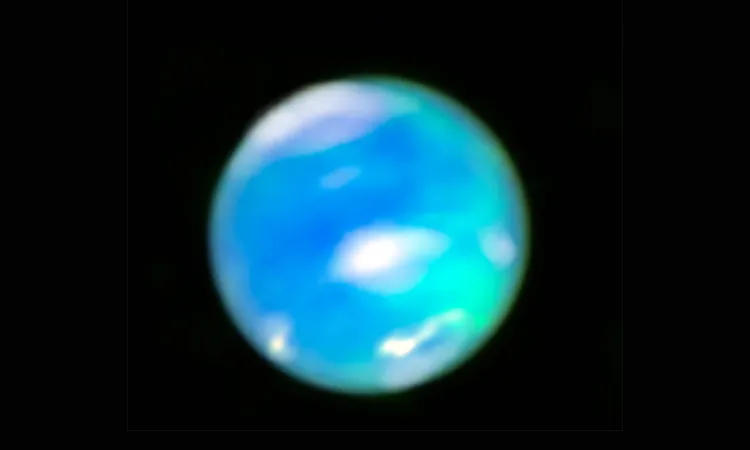
Stunning Discovery: Neptune's Spectacular Auroras Captured by James Webb Telescope for the First Time!
2025-04-05
Author: Ming
Get ready to be amazed! For the very first time, astronomers have witnessed Neptune's auroras in all their mesmerizing glory, thanks to NASA’s James Webb Space Telescope (JWST). This groundbreaking achievement has shifted our understanding of this distant giant planet and its unique atmospheric phenomena.
The JWST has delivered breathtaking images that showcase energetic particles crashing into Neptune's ionosphere, producing vibrant, glowing emissions. These high-energy particles, primarily sourced from the Sun, follow magnetic field lines before colliding with Neptune’s atmosphere, creating auroras now vividly depicted in the telescope’s near-infrared images.
A Long-Awaited Confirmation
Previously, the enigmatic auroras of gas giants like Jupiter, Saturn, and Uranus have been observed, but Neptune's lights remained elusive until now. Although NASA’s Voyager 2 hinted at their existence during its historic 1989 flyby, it wasn't until Webb’s powerful lens that this mystery was fully unraveled.
Lead researcher Henrik Melin, previously at the University of Leicester, exclaimed, “Seeing the auroras and the clarity of their emissions was nothing short of shocking!” In June 2023, the JWST utilized its Near-Infrared Spectrograph to capture this historic data, providing astronomers with crucial insights into Neptune’s atmospheric temperature and chemical composition.
Insights from H3+
A key aspect of this discovery involved identifying strong emissions from H3+, a molecule released during auroral activity. For the first time, astronomers recognized H3+ as a critical marker on Neptune, filling a significant gap in our understanding of this planet's auroral behavior. Heidi Hammel, a Webb interdisciplinary scientist, underscored the importance of H3+, stating, “We’ve seen its signature in other gas giants, and now we finally have confirmation for Neptune as well!”
Unique Auroral Behavior
Interestingly, Neptune's auroras are positioned at mid-latitudes rather than near the poles where Earth’s auroras occur. This unusual positioning results from Neptune's magnetic field, which Voyager 2 discovered to be tilted at 47 degrees in relation to its rotation axis. This tilt creates a complex interaction between solar particles and Neptune's magnetic environment, unveiling insights that could redefine our understanding of auroras across the solar system.
A Colder Future for Neptune
In a surprising twist, JWST's observations indicated that Neptune’s upper atmosphere has cooled dramatically since 1989, with temperatures dropping hundreds of degrees. This significant cooling factor could explain why Neptune's auroras had remained undetected for so long – colder temperatures normally weaken auroral brightness.
What Lies Ahead
This monumental discovery marks the dawn of a new era in the exploration of ice giants. Scientists are planning to closely monitor Neptune throughout a full solar cycle, exploring how solar activity influences its magnetic field and atmosphere. As astronomers continue their quest to uncover Neptune's secrets, there is a consensus on the importance of infrared-sensitive instruments for future missions to Uranus and Neptune.
As Leigh Fletcher from Leicester University aptly put it, “This observatory has finally opened the window onto this last, previously hidden ionosphere of the giant planets.”
The excitement shrouding this discovery was further thrust into the spotlight by the publication of these results in Nature Astronomy. This monumental leap in planetary science opens unprecedented avenues to unravel the mysteries of our solar system's outer realms.
Stay tuned for more thrilling discoveries from space!




 Brasil (PT)
Brasil (PT)
 Canada (EN)
Canada (EN)
 Chile (ES)
Chile (ES)
 Česko (CS)
Česko (CS)
 대한민국 (KO)
대한민국 (KO)
 España (ES)
España (ES)
 France (FR)
France (FR)
 Hong Kong (EN)
Hong Kong (EN)
 Italia (IT)
Italia (IT)
 日本 (JA)
日本 (JA)
 Magyarország (HU)
Magyarország (HU)
 Norge (NO)
Norge (NO)
 Polska (PL)
Polska (PL)
 Schweiz (DE)
Schweiz (DE)
 Singapore (EN)
Singapore (EN)
 Sverige (SV)
Sverige (SV)
 Suomi (FI)
Suomi (FI)
 Türkiye (TR)
Türkiye (TR)
 الإمارات العربية المتحدة (AR)
الإمارات العربية المتحدة (AR)